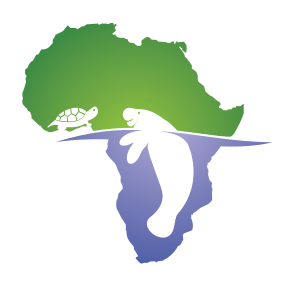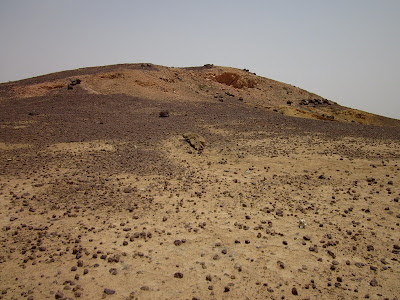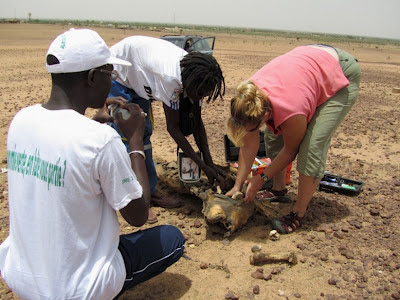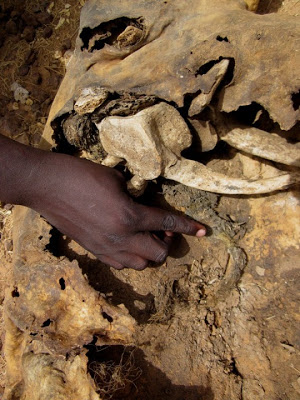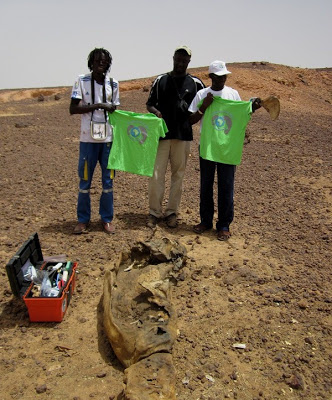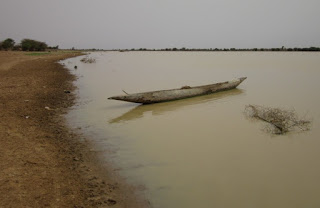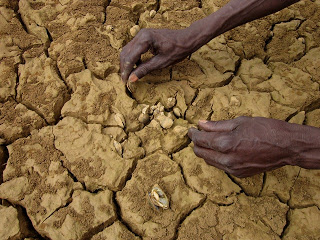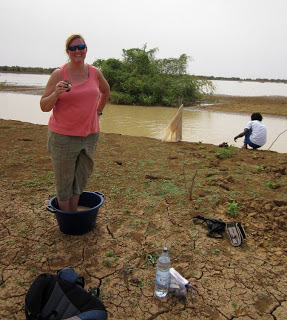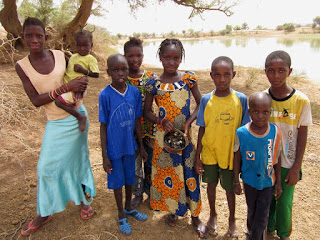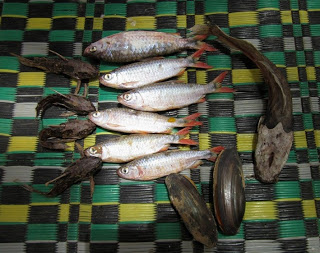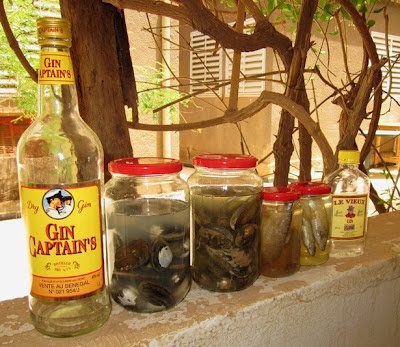Now there’s something I never thought I’d see. Can you find the manatee in this picture?
We drove to Kanel this morning and met up with Moutar, a local fisherman and our manatee contact, who has monitored the manatee situation here for many years. He took us to meet the local Water and Forestry officer, who knew where the manatee carcass that died last August was, and after some discussion he agreed to take us to it. He explained that when they found it last year, it was dead in a small pool where it had become trapped once the floodwaters receded. Apparently there are hundreds of such pools along the Senegal River floodplain, and most are in remote areas so no one would know if a manatee was trapped there. They dragged the carcass up this hillside (the guys called it a mountain, which, in this otherwise very flat landscape, I guess it is to them!) where it wouldn’t get washed away by the next floods, and over the past 10 months the unrelenting sun has baked it. The skin was as hard as a rock, and all internal organs were gone.
The good news is we were able to get alot of valuable samples: dried skin for genetics; bone, teeth and gut contents for dietary analysis, and ear bones for age determination. I also found a pelvic bone, which was great because male and female manatees each have distinctly shaped pelvic bones, which allowed me to identify this carcass as male. Massamba Niang of Water and Forestry (on left in photo below) and Moutar helped me collect samples. Since this was their first necropsy they got an impromptu manatee anatomy lesson.
Photo by Tomas Diagne
Inside the manatee we found dried gut contents and noticed fish net along with dried food remains, so unfortunately this guy had swallowed fish net. We will never know if he swallowed the net before or after he became trapped in the pool with no escape back to the river, but unfortunately it was a sad end for the poor thing.
At the end of the necropsy I gave the guys my project’s new manatee outreach t-shirts as a thank you for their efforts and enthusiasm, and I’ll send them standardized manatee datasheets and other information, since they were both keen to participate in the network.
While in Kanel we also visited two other sites where manatees are known to get trapped during the dry season. I’ve been to Wendou Kanel and Patouwel several times before (and have written about them in previous posts); these are both very large, deeper lakes that never completely dry out between flood seasons. Luckily we were told no one had seen any manatees at either site this year, and the fishermen had not had fish eaten out of nets or big holes in nets (both caused by manatees), so at least that was good news. It was still important for me to collect samples of everything manatees eat when they’re here, because I have manatee samples from previous years that I plan to compare to food sources through stable isotope analysis, so I needed food source reference samples. There weren’t many plants species around (nothing aquatic and only a couple species along the shoreline), but I’ve heard many reports that manatees eat fish and mollusks here, so I collected those.
Wendou Kanel
Moutar collecting small freshwater clams in the mud at the edge of Wendou Kanel.
I waded deep into the mud to collect some plants and clams and ended up getting stuck up to my knees! Luckily we had a big bucket for a nice foot soak…
At Patouwel I started looking for clams and a bunch of kids immediately joined me. I was amazed at how many mollusks there were- in 5 minutes these kids had filled an entire bucket!
I think there were at least 3 different species of mollusks (I hope to verify this soon), and the fishermen gave me 3 species of fish that they said manatees eat from their nets. After collecting we sat with the fishermen and their families under a big shady tree for awhile, there was a nice breeze, and we drank traditional mint tea and talked with them about manatees, their lives, and many other subjects.
Then it was time for the long, hot drive back to Ourosugui. By the time we got there, the fish and clams were already starting to rot and stink due to the 113 degree heat, and I hadn’t been able to find ethyl alcohol to preserve them in. So Tomas found a liquor store (a rarity in a Muslim country, especially out here) and we made due with some gin. Beggars can’t be chosers! Those of you who know me, know that I’m horribly allergic to gin, so I can promise you I didn’t drink any 🙂

